|
Most custom rod builders dread the prospect
of facing a customer who has just broken his
expensive custom rod. About the best thing that
can happen in such an instance, is that the
customer will tell the builder that it was an
accident, he broke it and is prepared to pay
full price for another one. The worst that can
happen, and which is the rule more than the
exception, is that the fisherman has no idea
how it broke, it must have been defective, and
he'll expect a new one in a couple weeks at no
charge.
Rod builders, much more than the average fisherman,
understand the things that cause rods to break. We
know that roughly 98% of all rod failures are due
to some sort of accident or abuse on the part of
fishermen, not actual defects in parts or assembly.
Over the years I've often wondered if at least
some of these failures couldn't be prevented if
only fishermen understood the various actions
that break rods and how to prevent them from
occurring. While fishing with other anglers, I've
often witnessed something which I knew was putting
a rod in danger and when I pointed it out to the
fisherman, he'd usually reply with something like,
"Gosh, I didn't know that would hurt a rod."
Designing and building a rod is only part of
the custom rod builder's job. Wise builders
spend a few minutes with each customer, going
over the proper care of their new rod and how
to avoid the things that can easily result in
breakage. Most anglers who have spent top dollar
on a quality rod are more than willing to take
good care of it, provided they are given some
guidelines for doing so. With that in mind,
let's cover some typical angling situations
that can break rods and which are easily
prevented by proper technique.
What Can Be Prevented
Accidents do happen. Tackle boxes get dropped
on rods, car doors shut on them, weighted flies
smash into them, kids step on them. There are a
host of accidental causes behind many rod breakages
and there's not much we can do to prevent them.
Things happen, rods get broken. This will never
change. But such accidental abuse may only account
for a small portion of rod breakage. I have no
numbers to back this up, but I feel fairly
confident that at least half of all rod breakages
are caused not by accidental impact or abuse, but
by simple angler ignorance. I've seen too many
fishermen use rods in a ways that were almost
guaranteed to cause breakage. Poking lures off
stumps with the rod tip, high sticking and high
reaching, overlining, etc., are all causes of
rod failure and yet they can all be prevented
through customer education. Accidents are things
we can't really control, but the latter, simple
angler abuse, can be controlled with just a little
insight. And this is one area that we can control
somewhat, through customer education.
*No rods were harmed during the production
of this article. Only low-modulus glass rods were
used during the photographing of dangerous rod
abuse.
Shop Failures
Fishermen like to flex rods before buying. They
shake, bend, wiggle and false cast any rod before
they decide whether to purchase it or not. And
many employ some strange and damaging techniques
in so doing. Not so many years ago I had a
fisherman tell me that he liked to "test" rods
in the local discount stores in order to find out
which ones were good and which ones were bad. He
said he just picked up a rod off the rack, bent
the tip around until it reached the butt, and if
it didn't break, he'd buy it. If it did break,
and according to him lots of them did while
undergoing his quality check, he just set it
back in the rack as best he could and moved on
to the next rod. According to him, the ones that
broke had something wrong with them. The ones
that held up were good rods and were the ones
you wanted to choose from.
I once had a customer buy a rod from me and
promptly break it right there in the shop! He
was hand flexing it to show another fisherman
"the action" and had pinched a spot about 12
inches back from the tip between his thumb and
forefinger and tweaked it over. It snapped like
a twig. According to him, it must have been
defective, after all, he had never even made
the first cast with it let alone fought a fish
with it.
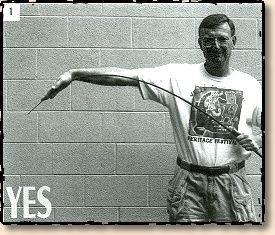
The trouble is, many fishermen don't even begin
to realize there is a proper way to test or hand
flex a rod. Done correctly, the rod or blank is
in no danger. Done incorrectly, failure is a great
possibility. Flexing a blank over its entire
length does not put a rod in danger of breakage.
Holding your palm against a rod tip and applying
moderate pressure is not going to break a rod (Photo 1).
Neither will pressing a rod tip into the ceiling
or against the floor at a moderate angle.
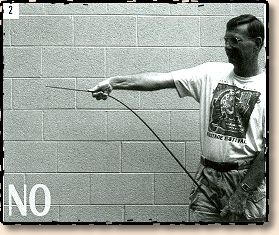
Unfortunately, few fishermen flex rods with this
much care or understanding. One of the most foolish
things anyone can do to rod is to grasp it between
thumb and forefinger and give it a sharp bend (Photo 2).
I've seen dozens of rods and blanks snapped off
by guys doing just this. Grasping the rod in this
manner puts undue pressure and a very sharp bend
into a very short area. Graphite in particular,
does not like this. Unfortunately, most guys who
break rods in this manner this never quite
understand just what happened. The rod must have
been defective, they reason. Actually, they broke
the rod in just the same way as they'd snap off
the end of a dry twig. Make sure your customers
don't do this to your in-house stock and make
sure they understand that there is both a safe
and an unsafe way to hand flex a blank.
Fighting Pressure
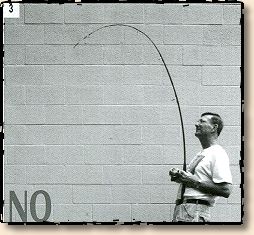
The way most fishermen attempt to apply more
pressure to a fish, or a snag, is by pulling
back harder and farther on the rod. Of course,
once you put more than about a 90 degree bend
in a rod, no more pressure is actually brought
to bear against the quarry. The rod is simply
put in jeopardy (Photo 3). Your customers need
to understand that there is a limit to the
degree of flex a rod can withstand as well as
a degree of flex that once exceeded, fails to
put any more pressure on the fish or obstruction.
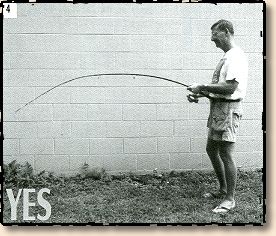
Ideally, the angler should utilize the most
powerful section of the rod, which lies in
the mid to butt areas. To do this, he should
keep a taut line and apply power from a fairly
low angle, say about 0 to 45 degrees from the
water (Photo 4). Once the rod butt starts to
move past 45 degrees, there is no longer any
sense in continuing upwards with it. Instead,
the angler drops the rod, recovering line with
the reel, and begins another "pump," keeping the
pressure on the fish by having the rod flexed
deep into the mid and butt area. Simply pulling
back farther and farther on the rod will not get
the powerful mid and butt sections of the rod
involved in the fight. You'll simply end up with
what is depicted here in photo #3, which puts
very little pressure on the fish. The power of
any rod is in the mid and butt sections. Get
your customer to use that power by starting
each rod pump low and pulling on the fish with
the lower mid and butt of the rod.
Here's another good way to apply maximum pressure
to a fish - drop the rod so that it is pointed at
the fish or obstruction. On a tight line, move
the butt of the rod to the side, recovering line
as quickly as it is gained. What you're attempting
to do here is take the rod out of the equation
entirely and employ what amounts to a tug of war
against the fish or obstruction. The situation
you create here is not at all unlike what you'd
have if the rod didn't even exist - a situation
where you're simply pulling against whatever is
on the other end with the line alone. When using
this method on a fish, however, you need to
understand that without the rod there to cushion
any sudden surges, you're likely to break light
line or tippets unless your reel drag is properly
set and functioning. Remember, this method takes
the rod out of the equation to a large degree and
your line is definitely the weak link in the chain.

If you're attempting to free a hopelessly snagged
lure, or to break the line on such, you can simply
put the rod directly in line with the obstruction
and pull back on the line without moving the rod
at all (Photo 5). On a baitcasting reel, lock the
spool with your thumb. On a spinning reel lock the
spool by dropping your forefinger onto it or cupping
it with one hand. On a fly reel, cup the reel and
spool so nothing turns. Now pull straight back with
the entire rod/reel assembly while keeping the rod
straight. Do exercise care, however, as lures or
sinkers that are freed this way can exit the water
like a bullet!
The number of rods broken each year by fishermen
attempting to free snagged lures would likely
boggle the mind. This is one very important
technique your customers need to know about.
And while you're at it, remind them that lures
and baits are generally less expensive than
rods. If something is going to be lost or
damaged, better a lure than a rod.
Landing Mistakes
One customer of mine was continually breaking
his rods near the tip. Every rod I made for him
came back broken about 4 to 12 inches back from
the tip after only a few outings. One day after
returning another broken rod to me in the shop,
I asked him to go through the motion of landing
a fish. His actions made the cause of his rod
failures all too obvious.
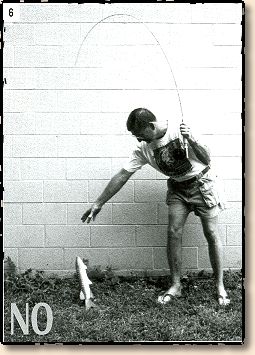
Bringing a fish in too close and then pointing
the rod skyward when you attempt the land him,
almost always results in the tip of the rod
folding over into a 180 degree bend. Few rods
will take this kind of abuse. Fly fishermen are
particularly bad about doing this as their long
rods make it impossible (or so they think) for
them to get the darn fish close enough for them
to land it. So they wind the fish up close and
point the rod skyward, never looking up to see
the horrendous bend they're putting in the rod.
The bottom of the rod is pointing straight up,
and the tip is pointing straight down (Photo 6).
Failure is imminent.
Instruct your customer on the finer points of
landing fish. Improper landing techniques are
the undoing of many a rod. Always leave a length
of line beyond the rod tip that is equal to, or
greater than, your rod's overall length. That's
right, with a 6 foot rod you want at least 6 feet
of line past the rod tip when attempting to land
a fish. With a 9 footer, keep at least 9 feet of
line, if not a few feet more, past the rod tip.
 When landing a fish, turn your hand over and
outward so that the rod tip is not flexed past
90 degrees (Photo 7). The fish will fall gently
to hand, net or gaff without your rod being put
in danger.
When landing a fish, turn your hand over and
outward so that the rod tip is not flexed past
90 degrees (Photo 7). The fish will fall gently
to hand, net or gaff without your rod being put
in danger.
While I'm sure most of you already know this,
your customers need to understand that using
the rod to lift and swing any decent sized fish
over the gunwale and into the boat is not good
landing technique. I know the bass pros do it
and get away with it a lot of the time. But if
you're not fishing big money tournaments where
you can afford to bust rods, you're better off
using a much safer landing technique. Explain
this to your customers.
Fishing reels are not winches. They're not made
for direct retrieve against any sort of heavy
load. Their purpose is to pay out line under
pressure and to recover it when there is no
pressure. I'm sure all of us have been in a
boat with an angler who hooks a nice fish and
then starts winding and cranking away. The rod
tip bends over and past 90 degrees and the angler
just winches away on the reel, keeping the rod
up high and with a tight bend in it. This is
often referred to as "high sticking," again
pretty much what was depicted in photo #3. With
spinning equipment, you'll often hear the spool
clicking or whining as the angler simply slips
the drag, rotating the spool around the spindle
shaft, severely twisting the line but never
actually gaining any!
I don't want to delve into the intricacies of
reel drags and proper settings, other than to
point out that a reel is not meant for winching
in a fish. The rod moves the fish towards us and
the reel simply takes up the slack line as the
rod is dropped back down and readied for another
pump. All the while, the rod is never brought
back so far as to put more than a 90 degree
bend in it. Depending on the line and reel
drag setting, the rod can be flexed deeply
into its power zone and efficient power is
then brought to bear against the fish, hopefully
moving him the direction you wish him to go.
When rod flex begins to move past 90 degrees,
it's time to lower it back towards the fish all
the while using the reel to recover the gained
line. Your customer should understand that this
is not only the most effective way to fight a
fish, but it does not pose any harm to his
equipment.

One aside that I need to mention is that the
tendency for most anglers is to move the fish
by sweeping the rod upwards. Yet quite often,
the easiest way to move the fish is to apply
pressure from the side (Photo 8). For whatever
reason, fish tend to resist the urge to be
pulled upwards, but do not resist nearly as
much to being pulled to the side. Try it some
time and see for yourself.
High Reaching
A rod is a lever. To the fisherman it's a third
order lever and to the fish, its a second order
lever. In both cases he (the fish) has the
advantage over you in terms of power. If he's
big enough and strong enough, the tendency when
you tire or need to move the fish, is to reach
up on the rod, shortening the lever and trying
to reduce the fish's lever advantage (Photo 9).
 It's effective for sure, but its also tough on
rods. All rods feature a progressive action and
as the load on the rod increases, the rod flexes
further and further down towards the butt into
the beefiest and strongest part of the structure
(at least if you keep recovering line and resist
the temptation to simply aim the rod to the heavens
and winch away).. If you've got maximum pressure
on a fish and you suddenly reach up and beyond
that very strong part of the rod, isolating the
much weaker mid or tip section with that same
pressure, you're going to break it. Customers
need to understand that they can still beat a
fish quickly without endangering their rod.
It's effective for sure, but its also tough on
rods. All rods feature a progressive action and
as the load on the rod increases, the rod flexes
further and further down towards the butt into
the beefiest and strongest part of the structure
(at least if you keep recovering line and resist
the temptation to simply aim the rod to the heavens
and winch away).. If you've got maximum pressure
on a fish and you suddenly reach up and beyond
that very strong part of the rod, isolating the
much weaker mid or tip section with that same
pressure, you're going to break it. Customers
need to understand that they can still beat a
fish quickly without endangering their rod.
The purpose of the fighting butt on fly rods,
or longer handles on most casting and spinning
rods, is so you can get the rod butt up under
your forearm thereby taking pressure off your
wrist and putting it on the whole of your arm
and shoulder.
The tight-line sideways movement outlined earlier
in this article is sometimes also a good practice
in these situations. Take the rod out of the
equation entirely. Remove the lever advantage
the fish has on you and whip him in a tug of
war. It's more effective and you won't break
a rod doing it.
The Really Dumb Mistakes
I can't count the number of rods I've seen in
the act of being broken and the entire time the
event is taking place the fisherman is totally
oblivious to what's going on. I've watched fly
fishermen attempt to pull the line/leader
connection through the guides only to have it
catch or snag on a guide and stop. The fisherman
keeps pulling on the fly end of the leader,
effectively folding the tip of the rod over
into a sharp arc. This is very similar to what
I spoke of earlier when talking about landing
a fish. Most line/leader connections can easily
be shaken through the guides with a few short,
false casting type motions, or by lowering the
rod and waggling it from side to side. Make sure
your fly fishing customers know how to do this.
Then you've got the surf fisherman who travels
up and down the beach in his 4WD vehicle, rods
stuck into his bumper mounted rod holders, hood
and sinkers secured in one of the guide frames
or rings. As bad as this is on the guides, it's
pure torture on the rod blank. Those surf sinkers
or metal lures tick, tap and slap the rod surface
as the vehicle motors down the road or cruises
the dunes. The fishermen stops and climbs out
and loads up his next cast only to have the rod
snap. Another defective rod, or so he thinks. If
the sinker or lure has to beat and bang on anything,
make it the handle, not the rod blank surface.
Watch fishermen as they attempt to get a too
long rod into a car, truck or boat with a too
small opening. They think that if they only
double the rod up for just a second, they'll
be okay. Often they're not. A few "words to
the wise" with regard to these type errors can
spare many a rod from breakage. Customers need
to understand the ramifications that any sharp
or sudden impact to the rod surface can have
down the road. Rods that are subject to such
abuse may not break at the time of the impact,
but rather fail a little later leaving the
fisherman to believe he did nothing to cause
the break.
Fish Fighting Tips
- Never flex a rod by hand by pinching the
rod between thumb and forefinger.
- When flexing a rod by hand, flex the blank
over its full length, never just over a short area.
- Never put more than a 90 degree flex into
a fishing rod either while fighting or landing
a fish.
- A rod's power is concentrated in the lower
mid and butt sections. Apply pressure against a
fish by pulling with the lower mid and butt areas
of the rod, keeping your lifting and pumping action
from between just under 0 degrees and up to about
45 or 50 degrees (8 to 11 o'clock).
- When attempting to free your lure or fly
from a snag or obstruction, point the rod directly
at the obstruction and hold the reel spool so it
cannot slip. Pull straight back against the snag
and do not put any flex into the rod. Exercise care,
as a freed lure or sinker can come at you like a bullet.
- Pay attention to the line you use on any rod.
The line should always be the weak link in the chain,
not the rod. Using a higher line test [OVERLINING]
than recommended and applying maximum pressure
with it can easily break a rod.
- Transport and store rods with a reasonable amount
of care. Quality graphite rods are terribly strong
but do not hold up well to bumps, bangs, scrapes
and other types of impact or abrasion.
Conclusion
There are some things in fishing that you simply
cannot control and that are going to break rods.
But it only makes sense to at least try to offer
some input on those things that either you or
your customer can control. Most custom rod
customers would prefer that their expensive
new rod didn't break, and they are only too
happy to try and prevent breakage by practicing
safe and effective techniques. But they can't do
that unless they know how. Here's one more chance
for you, the custom rod builder, to impart some
knowledge and extra value into each custom rod
sale. And you just might be sparing yourself a
future headache in the process!
~ Tom Kirkman

If you would like to comment on this or any other article please feel free to
post your views on the FAOL Bulletin Board!
|


 When landing a fish, turn your hand over and
outward so that the rod tip is not flexed past
90 degrees (Photo 7). The fish will fall gently
to hand, net or gaff without your rod being put
in danger.
When landing a fish, turn your hand over and
outward so that the rod tip is not flexed past
90 degrees (Photo 7). The fish will fall gently
to hand, net or gaff without your rod being put
in danger. It's effective for sure, but its also tough on
rods. All rods feature a progressive action and
as the load on the rod increases, the rod flexes
further and further down towards the butt into
the beefiest and strongest part of the structure
(at least if you keep recovering line and resist
the temptation to simply aim the rod to the heavens
and winch away).. If you've got maximum pressure
on a fish and you suddenly reach up and beyond
that very strong part of the rod, isolating the
much weaker mid or tip section with that same
pressure, you're going to break it. Customers
need to understand that they can still beat a
fish quickly without endangering their rod.
It's effective for sure, but its also tough on
rods. All rods feature a progressive action and
as the load on the rod increases, the rod flexes
further and further down towards the butt into
the beefiest and strongest part of the structure
(at least if you keep recovering line and resist
the temptation to simply aim the rod to the heavens
and winch away).. If you've got maximum pressure
on a fish and you suddenly reach up and beyond
that very strong part of the rod, isolating the
much weaker mid or tip section with that same
pressure, you're going to break it. Customers
need to understand that they can still beat a
fish quickly without endangering their rod.





